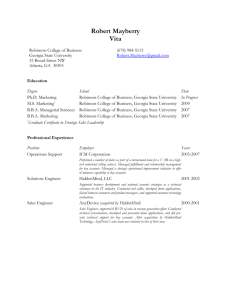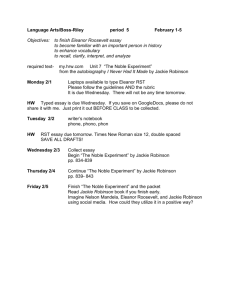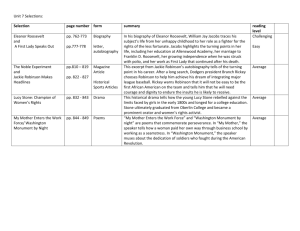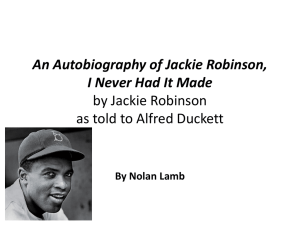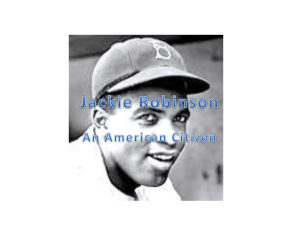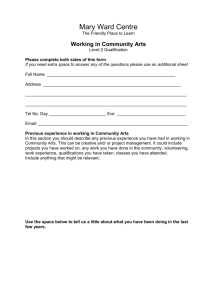Jackie Robinson - Georgia Historical Society
advertisement
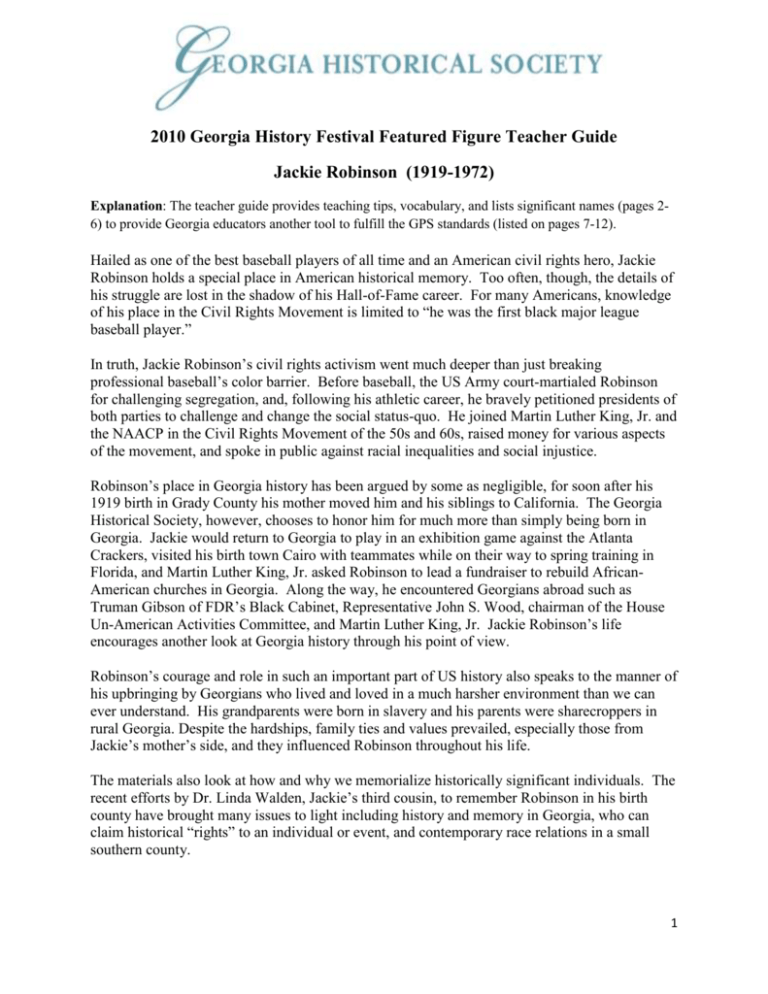
2010 Georgia History Festival Featured Figure Teacher Guide Jackie Robinson (1919-1972) Explanation: The teacher guide provides teaching tips, vocabulary, and lists significant names (pages 26) to provide Georgia educators another tool to fulfill the GPS standards (listed on pages 7-12). Hailed as one of the best baseball players of all time and an American civil rights hero, Jackie Robinson holds a special place in American historical memory. Too often, though, the details of his struggle are lost in the shadow of his Hall-of-Fame career. For many Americans, knowledge of his place in the Civil Rights Movement is limited to “he was the first black major league baseball player.” In truth, Jackie Robinson’s civil rights activism went much deeper than just breaking professional baseball’s color barrier. Before baseball, the US Army court-martialed Robinson for challenging segregation, and, following his athletic career, he bravely petitioned presidents of both parties to challenge and change the social status-quo. He joined Martin Luther King, Jr. and the NAACP in the Civil Rights Movement of the 50s and 60s, raised money for various aspects of the movement, and spoke in public against racial inequalities and social injustice. Robinson’s place in Georgia history has been argued by some as negligible, for soon after his 1919 birth in Grady County his mother moved him and his siblings to California. The Georgia Historical Society, however, chooses to honor him for much more than simply being born in Georgia. Jackie would return to Georgia to play in an exhibition game against the Atlanta Crackers, visited his birth town Cairo with teammates while on their way to spring training in Florida, and Martin Luther King, Jr. asked Robinson to lead a fundraiser to rebuild AfricanAmerican churches in Georgia. Along the way, he encountered Georgians abroad such as Truman Gibson of FDR’s Black Cabinet, Representative John S. Wood, chairman of the House Un-American Activities Committee, and Martin Luther King, Jr. Jackie Robinson’s life encourages another look at Georgia history through his point of view. Robinson’s courage and role in such an important part of US history also speaks to the manner of his upbringing by Georgians who lived and loved in a much harsher environment than we can ever understand. His grandparents were born in slavery and his parents were sharecroppers in rural Georgia. Despite the hardships, family ties and values prevailed, especially those from Jackie’s mother’s side, and they influenced Robinson throughout his life. The materials also look at how and why we memorialize historically significant individuals. The recent efforts by Dr. Linda Walden, Jackie’s third cousin, to remember Robinson in his birth county have brought many issues to light including history and memory in Georgia, who can claim historical “rights” to an individual or event, and contemporary race relations in a small southern county. 1 Early Encounters Vocabulary: Affront: to insult, especially to the face, by behavior or language; to cause offense to. Jim Crow: ethnic discrimination especially against blacks by legal enforcement or traditional sanctions. Literacy Tests: the government practice of testing the literacy of potential citizens at the federal level, and potential voters at the state level -- used as a means for denying suffrage to African Americans. Lynching: to put to death (as by hanging) by mob action without legal sanction Poll Taxes: a tax of a fixed amount per person levied on adults and often linked to the right to vote -- used as a means for denying suffrage to African Americans. Sharecropping: a system of tenant farming where a an individual or family is provided with credit for seed, tools, living quarters, and food by a landowner, and then works a piece of that land and receives an agreed share of the value of the crop minus charges (for items mentioned above purchased with credit). White Primaries: primary elections in which non-white voters were prohibited from participating. Names to Remember: Karl Downs Rachel Isum Jesse Owens Mack Robinson Mallie Robinson Teaching Tips & Ideas: 1. Ask students to research early 20th century Southern plantations. Examine and write about the life of tenant farmers and sharecroppers. Draw a map or create a model of a plantation that includes the main house, outbuildings, workshops, barns, tenant houses, crops, etc. 2. Compare and contrast a slave’s life to a sharecropper’s life. Jackie called sharecropping “a more sophisticated kind of slavery.” Was he right? 3. Have students learn the meaning and purpose of the “Civil War Amendments.” Write an essay discussing the tools, such as poll taxes, that white officials used to circumvent those amendments. 4. Mack Robinson came in second to Jesse Owens in the 1936 Olympics. How does the fact that we know so little about Mack reflect our society’s focus on winners alone? Is winning an Olympic Silver Medal not enough? 5. Jackie credited his wife, Rachel, with much of his success. Her support and advice helped him deal with much of the hatred he faced and the decisions he had to make. Using online 2 interviews and other sources, write a biography of Rachel. Younger students might create a diorama depicting an historical scene in her life. Military Years Vocabulary: Court Martial: a court consisting of commissioned officers and in some instances enlisted personnel for the trial of members of the armed forces or others within its jurisdiction. Exasperated: irritated, annoyed, or angry. Inequity: an instance of injustice or unfairnes. Insubordination: disobedient to authority. Palpable: capable of being touched or felt; easily perceptible; easily perceptible by the mind. Protocol: a code prescribing strict adherence to correct etiquette and precedence (as in diplomatic exchange and in the military services). Segregation: : the separation or isolation of a race, class, or ethnic group by enforced or voluntary residence in a restricted area, by barriers to social intercourse, by separate educational facilities, or by other discriminatory means. Names to Remember: Captain William Cline Truman Gibson Joe Louis Pittsburgh Courier Milton Reneger Sugar Ray Robinson Teaching Tips & Ideas: 1. If Jackie had been found guilty and imprisoned, or if he had gone to Europe and died in battle, who might have been the first black Major League baseball player? Research the careers of other African-American baseball players of the era and argue for their place as Jackie’s substitute. 2. Truman Gibson was a member of FDR’s “Black Cabinet.” What was the Black Cabinet and who were the other members? 3. Joe Louis and Jackie Robinson were not the only famous people to join or be drafted into the military during WWII. Who were some other famous names, what was their civilian profession, and what did they do in the military? How did the US military use famous people to build support for the war effort? For a more detailed look at Jackie’s court martial, visit the National Archives website and read “Jim Crow, Meet Lieutenant Robinson: A 1944 Court-Martial .” 3 Breaking Baseball’s Color Barrier Vocabulary: Bean balls: a pitch thrown at a batter's head. Discrimination: to make a difference in treatment or favor on a basis other than individual merit (such as race, nationality, or gender). Endorsement: to approve openly; to express support or approval of publicly and definitely; to recommend (as a product or service) usually for financial compensation. Farm team: a team or club whose role is to provide experience and training for young players, with an agreement that any successful players can move on to a higher level at a given point. Humility: not proud or haughty, not arrogant or assertive; reflecting, expressing, or offered in a spirit of deference or submission. Ruse: a wily subterfuge. Stellar: outstanding Names to Remember: A.B. “Happy” Chandler Branch Rickey Brooklyn Dodgers Ku Klux Klan Samuel Green Kansas City Monarchs Teaching Tips & Ideas: 1. In 1946, the year Jackie played for the Montreal Royals, professional football allowed the first black players onto the field. Ask students to research who they were (hint: two played with Jackie at UCLA as part of the “Gold Dust Trio”), compare and contrast their experience to Jackie’s, and consider why they and professional football received so little attention to the historic integration. 2. Consider Branch Rickey’s comments to the group in Brooklyn. Have students debate the validity of Rickey’s statements. Would large crowds of black supporters shouting in celebration ruined Jackie’s chances of breaking the barrier? 3. Have students research the endorsements of their favorite celebrities. How much are they paid for those endorsements? Do celebrities send any negative messages by making so much money, or are they deserving of it as leaders in their field? How do product manufacturers use specific celebrities to target certain demographics? 4. And speaking of money. . .There are many theories that capitalism had as much to do with the integration of baseball as anyone’s commitment to civil rights or winning pennants. Have students write about or debate the notion, that the bottom line encouraged integration. They might consider that including minorities on the field brought minorities 4 into the stands, that championship teams sold tickets and memorabilia, and that all stars kept people of all backgrounds in the seats from year to year. Robinson and the Civil Rights Movement Vocabulary: Blacklisting: to identify a person or persons for disapproval, punishment, or boycott. Communism: a theory advocating elimination of private property; a system in which goods are owned in common and are available to all as needed. Congregation: an assembly of persons or a gathering, especially an assembly of persons met for worship and religious instruction; a religious community. Infiltration: to enter or become established in gradually or unobtrusively usually for subversive purposes Layman: a person who is not a member of the clergy; a person who does not belong to a particular profession or who is not expert in some field Lobby: to promote (as a project) or secure the passage of (as legislation) by influencing public officials; to attempt to influence or sway (as a public official) toward a desired action Scrutiny: a close and detailed scrutiny, investigation, or inspection Names to Remember: Albany Movement Council on African Affairs (CAA) House Un-American Activities Committee Martin Luther King, Jr. Paul Robeson Governor Nelson Rockefeller Southern Christian Leadership Conference (SCLC) Student Nonviolent Coordinating Committee (SNCC) John S. Wood Remembering Robinson Teaching Tips & Ideas: 1. Ask students to pick someone in their family to whom they would like to dedicate a memorial. Using the GHS Historical Marker index as a reference, have the students write a short narrative summarizing their relative’s life and achievements. Require a location proposal in support of the student’s ideas for marker placement. Should the marker be placed near: A birthplace? Outside of the home in which the relative lived most of his/ her life? At the county line? Near the site of a significant event in the person’s life? 5 2. Using the above assignment, have students research the life of a famous person they admire. Write the text for a historical marker, choose a location for that marker, and write and deliver a dedication speech. 3. Debate the decision to memorialize Jackie Robinson in Grady County, Georgia. In what other Georgia locations could he be remembered? Can and should a historically significant figure be honored in more than one place? Provide a map of the United States and ask students to label locations where Robinson might be remembered. Georgia Performance Standards (GPS) Social Studies 6 SSKH3 The student will correctly use words and phrases related to chronology and time to explain how things change. a. Now, long ago b. Before, after c. Morning, afternoon, night d. Today, tomorrow, yesterday e. First, last, next f. Day, week, month, year g. Past, present, future SSKCG2 The student will retell stories that illustrate positive character traits and will explain how the people in the stories show the qualities of honesty, patriotism, loyalty, courtesy, respect, truth, pride, self-control, moderation, and accomplishment. SSKE1 The student will describe the work that people do (police officer, fire fighter, soldier, mail carrier, baker, farmer, doctor, and teacher). SSKE2 The student will explain that people earn income by exchanging their human resources (physical or mental work) for wages or salaries. SSKE4 The student will explain that people must make choices because they cannot have everything they want. SS5H8 The student will describe the importance of key people, events, and developments between 1950-1975. a. Discuss the importance of the Cuban Missile Crisis and the Vietnam War. b. Explain the key events and people of the Civil Rights movement; include Brown v. Board of Education (1954), the Montgomery Bus Boycott, the March on Washington, Civil Rights Act, Voting Rights Act, and civil rights activities of Thurgood Marshall, Rosa Parks, and Martin Luther King, Jr. c. Describe the impact on American society of the assassinations of President John F. Kennedy, Robert F. Kennedy, and Martin Luther King, Jr. d. Discuss the significance of the technologies of television and space exploration. SS8H11 The student will evaluate the role of Georgia in the modern civil rights movement. a. Describe major developments in civil rights and Georgia’s role during the 1940s and 1950s; include the roles of Herman Talmadge, Benjamin Mays, the 1946 governor’s race and the end of the white primary, Brown v. Board of Education, Martin Luther King, Jr., and the 1956 state flag. b. Analyze the role Georgia and prominent Georgians played in the Civil Rights Movement of the 1960s and 1970s; include such events as the founding of the Student Non-Violent Coordinating Committee (SNCC), Sibley Commission, admission of Hamilton Holmes and Charlayne Hunter to the University of Georgia, Albany Movement, March on Washington, Civil 7 Rights Act, the election of Maynard Jackson as mayor of Atlanta, and the role of Lester Maddox. c. Discuss the impact of Andrew Young on Georgia. SSUSH22 The student will identify dimensions of the Civil Rights Movement, 1945-1970. a. Explain the importance of President Truman’s order to integrate the U.S. military and the federal government. b. Identify Jackie Robinson and the integration of baseball. c. Explain Brown v. Board of Education and efforts to resist the decision. d. Describe the significance of Martin Luther King, Jr.’s Letter from a Birmingham Jail and his I Have a Dream Speech. e. Describe the causes and consequences of the Civil Rights Act of 1964 and the Voting Rights Act of 1965. SSUSH24 The student will analyze the impact of social change movements and organizations of the 1960s. a. Compare and contrast the Student Non-Violent Coordinating Committee (SNCC) and the Southern Christian Leadership Conference (SCLC) tactics; include sit-ins, freedom rides, and changing composition. b. Describe the National Organization of Women and the origins and goals of the modern women’s movement. c. Analyze the anti-Vietnam War movement. d. Analyze Cesar Chavez and the United Farm Workers’ movement. e. Explain the importance of Rachel Carson’s Silent Spring and the resulting developments; include Earth Day, the creation of the Environmental Protection Agency (EPA), and the modern environmental movement. f. Describe the rise of the conservative movement as seen in the presidential candidacy of Barry Goldwater (1964) and the election of Richard M. Nixon (1968). English & Language Arts ELA4R3 The student understands and acquires new vocabulary and uses it correctly in reading and writing. The student a. Reads a variety of texts and incorporates new words into oral and written language. b. Determines the meaning of unknown words using their context. c. Identifies the meaning of common root words to determine the meaning of unfamiliar words. d. Determines meanings of words and alternate word choices using a dictionary or thesaurus. e. Identifies the meaning of common prefixes (e.g., un-, re-, dis-). f. Identifies the meaning of common idioms and figurative phrases. g. Identifies playful uses of language (e.g., puns, jokes, palindromes). h. Recognizes and uses words with multiple meanings (e.g., sentence, school, hard) and determines which meaning is intended from the context of the sentence. i. Identifies and applies the meaning of the terms antonym, synonym, and homophone. 8 ELA4R4 The student reads aloud, accurately (in the range of 95%), familiar material in a variety of genres, in a way that makes meaning clear to listeners. The student a. Uses letter-sound knowledge to decode written English and uses a range of cueing systems (e.g., phonics and context clues) to determine pronunciation and meaning. b. Uses self-correction when subsequent reading indicates an earlier miscue (selfmonitoring and self-correcting strategies). c. Reads with a rhythm, flow, and meter that sounds like everyday speech (prosody). ELA5R3 The student understands and acquires new vocabulary and uses it correctly in reading and writing. The student a. Reads a variety of texts and incorporates new words into oral and written language. b. Determines the meaning of unfamiliar words using context clues (e.g., definition, example). c. Determines the meaning of unfamiliar words using knowledge of common roots, suffixes, and prefixes. d. Determines pronunciations, meanings, alternate word choices, and parts of speech of words using dictionaries and thesauruses. e. Identifies the meaning of common prefixes (e.g., un-, re-, dis-). f. Identifies the meaning of common idioms and figurative phrases. g. Identifies playful uses of language (e.g., puns, jokes, palindromes). h. Recognizes and uses words with multiple meanings (e.g., sentence, school, hard) and determines which meaning is intended from the context of the sentence. i. Identifies and applies the meaning of the terms antonym, synonym, and homophone. ELA5R4 The student reads aloud, accurately (in the range of 95%), familiar material in a variety of genres, in a way that makes meaning clear to listeners. The student a. Uses letter-sound knowledge to decode written English and uses a range of cueing systems (e.g., phonics and context clues) to determine pronunciation and meaning. b. Uses self-correction when subsequent reading indicates an earlier miscue (selfmonitoring and self-correcting strategies). c. Reads with a rhythm, flow, and meter that sounds like everyday speech (prosody). ELA6R2 The student understands and acquires new vocabulary and uses it correctly in reading and writing. The student a. Determines the meaning of unfamiliar words by using word, sentence, and paragraph clues. b. Uses knowledge of Greek and Latin affixes to understand unfamiliar vocabulary. c. Identifies and interprets words with multiple meanings. d. Uses reference skills to determine pronunciations, meanings, alternate word choices, and parts of speech of words. ELA6R3 The student reads aloud, accurately (in the range of 95%), familiar 9 material in a variety of genres, in a way that makes meaning clear to listeners. The student a. Uses letter-sound knowledge to decode written English and uses a range of cueing systems (e.g., phonics and context clues) to determine pronunciation and meaning. b. Uses self-correction when subsequent reading indicates an earlier miscue (self-monitoring and self-correcting strategies). c. Reads with a rhythm, flow, and meter that sounds like everyday speech (prosody). ELA7R2 The student understands and acquires new vocabulary and uses it correctly in reading and writing. The student a. Determines the meaning of unfamiliar words using context clues (e.g., contrast, cause and effect, etc.). b. Uses knowledge of Greek, Latin, and Anglo-Saxon roots and affixes to determine the meaning of unfamiliar words. c. Identifies and explains idioms and analogies in prose and poetry. d. Determines word meanings through the use of definition, example, restatement, or contrast. ELA7R3 The student reads aloud, accurately (in the range of 95%), familiar material in a variety of genres, in a way that makes meaning clear to listeners. The student a. Uses letter-sound knowledge to decode written English and uses a range of cueing systems (e.g., phonics and context clues) to determine pronunciation and meaning. b. Uses self-correction when subsequent reading indicates an earlier miscue (selfmonitoring and self-correcting strategies). c. Reads with a rhythm, flow, and meter that sounds like everyday speech (prosody). ELA7RC3 The student acquires new vocabulary in each content area and uses it correctly. The student a. Demonstrates an understanding of contextual vocabulary in various subjects. b. Uses content vocabulary in writing and speaking. c. Explores understanding of new words found in subject area texts. ELA7RC4 The student establishes a context for information acquired by reading across subject areas. The student a. Explores life experiences related to subject area content. b. Discusses in both writing and speaking how certain words and concepts relate to multiple subjects. c. Determines strategies for finding content and contextual meaning for unfamiliar words or concepts. 10 ELA8R2 The student understands and acquires new vocabulary and uses it correctly in reading and writing. The student a. Determines pronunciations, meanings, alternate word choices, parts of speech, or etymologies of words. b. Determines the meaning of unfamiliar words in content and context specific to reading and writing. c. Demonstrates an initial understanding of the history of the English Language. ELA8R3. The student reads aloud, accurately (in the range of 95%), familiar material in a variety of genres, in a way that makes meaning clear to listeners. The student a. Uses letter-sound knowledge to decode written English and uses a range of cueing systems (e.g., phonics and context clues) to determine pronunciation and meaning. b. Uses self-correction when subsequent reading indicates an earlier miscue (self-monitoring and self-correcting strategies). c. Reads with a rhythm, flow, and meter that sounds like everyday speech (prosody). ELA8RC3 The student acquires new vocabulary in each content area and uses it correctly. The student a. Demonstrates an understanding of contextual vocabulary in various subjects. b. Uses content vocabulary in writing and speaking. c. Explores understanding of new words found in subject area texts. ELA8RC4 The student establishes a context for information acquired by reading across subject areas. The student a. Explores life experiences related to subject area content. b. Discusses in both writing and speaking how certain words and concepts relate to multiple subjects. c. Determines strategies for finding content and contextual meaning for unfamiliar words or concepts. ELA9RC3 The student acquires new vocabulary in each content area and uses it correctly. The student a. Demonstrates an understanding of contextual vocabulary in various subjects. b. Uses content vocabulary in writing and speaking. c. Explores understanding of new words found in subject area texts. ELA9RC4 The student establishes a context for information acquired by reading across subject areas. The student a. Explores life experiences related to subject area content. b. Discusses in both writing and speaking how certain words and concepts relate to multiple subjects. c. Determines strategies for finding content and contextual meaning for unfamiliar words or 11 concepts. ELA10RC3 The student acquires new vocabulary in each content area and uses it correctly. The student a. Demonstrates an understanding of contextual vocabulary in various subjects. b. Uses content vocabulary in writing and speaking. c. Explores understanding of new words found in subject area texts. ELA10RC4 The student establishes a context for information acquired by reading across subject areas. The student a. Explores life experiences related to subject area content. b. Discusses in both writing and speaking how certain words and concepts relate to multiple subjects. c. Determines strategies for finding content and contextual meaning for unfamiliar words or concepts. ELA11C1 The student demonstrates understanding and control of the rules of the English language, realizing that usage involves the appropriate application of conventions and grammar in both written and spoken formats. The student a. Demonstrates an understanding of proper English usage and control of grammar, sentence and paragraph structure, diction, and syntax. b. Correctly uses clauses (i.e., main and subordinate), phrases (i.e., gerund, infinitive, and participial), and mechanics of punctuation (i.e., end marks, commas, semicolons, quotations marks, colons, ellipses, hyphens). c. Demonstrates an understanding of sentence construction (i.e., subordination, proper placement of modifiers, parallel structure) and proper English usage (i.e., consistency of verb tenses, agreement). ELA12C1 The student demonstrates understanding and control of the rules of the English language, realizing that usage involves the appropriate application of conventions and grammar in both written and spoken formats. The student a. Demonstrates an understanding of proper English usage and control of grammar, sentence and paragraph structure, diction, and syntax. b. Correctly uses clauses (i.e., main and subordinate), phrases (i.e., gerund, infinitive, and participial), and mechanics of punctuation (i.e., end marks, commas, semicolons, quotation marks, colons, ellipses, hyphens). c. Demonstrates an understanding of sentence construction (i.e., subordination, proper placement of modifiers, parallel structure) and proper English usage (i.e., consistency of verb tense, agreement). 12

